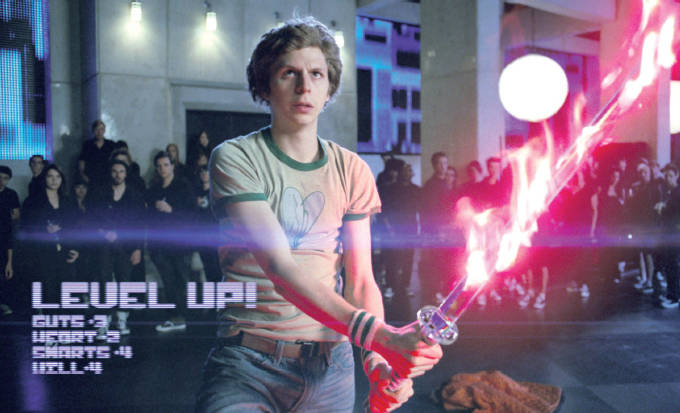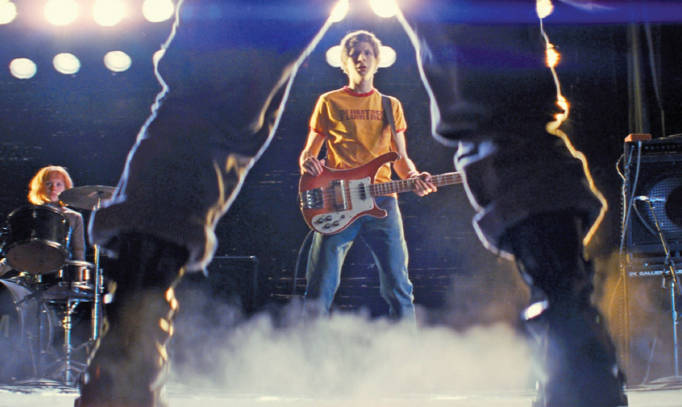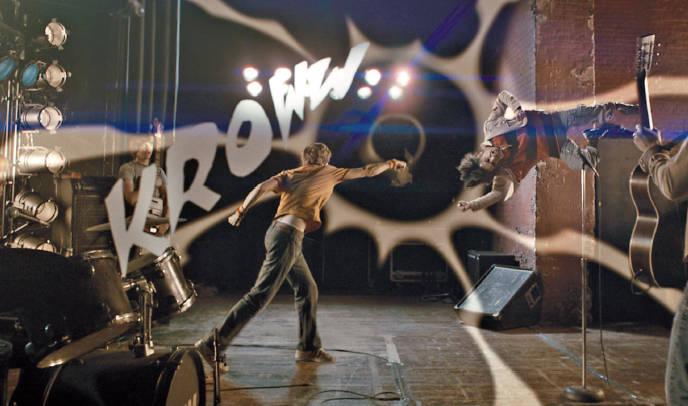William Akana, Scott Pilgrim vs. the World: A Hell of a Ride
| William Akana | Scott Pilgrim vs. the World: A Hell of a Ride |
To learn how Akana developed his thesis and responses to objections, turn to A Writer at Work on pp. 399–400.
THIS EVALUATION ESSAY was written by student William Akana for his composition course. The assignment prompt asked students to choose a film and write a review that includes a close analysis of the cinematic techniques used in at least one important scene. Akana’s instructor illustrated various cinematic techniques, such as camera angles and movements, and demonstrated how to take screen shots, explaining that students can use visuals for a class project without asking permission, but to publish them they would have to get permission, as we did. As you read, consider these questions as well as those in the margin:
- How well do the screen shots illustrate Akana’s analysis and support his evaluation?
- How would you describe Akana’s tone in this essay? How is his tone affected by the fact that he only uses the first person pronoun “I” to refer to himself only in the opening and closing paragraphs?
Notice that Akana used film stills—screen shots he took from a DVD of the movie—to illustrate his review. Because he used these visuals for a class project and not for public distribution, he did not have to get permission to use them. We did, however.
Basic Features
A Well-Presented Subject
A Well-Supported Judgment
An Effective Response to Objections and Alternative Judgments
A Clear, Logical Organization
1As I leaned back in the movie theater seat, accompanied by my friends on a typical Saturday night, I knew I was in for something special. I was reassured; not only had my friends and I reached a unanimous vote to watch Scott Pilgrim vs. the World, but two of my friends had already seen the film and were eager to see it again. As soon as Scott Pilgrim vs. the World began, with its presentation of the classic Universal Studios introduction in old-timer eight-bit music and pixilated format, I knew I was in for one hell of a ride. From start to finish, Scott Pilgrim vs. the World delivers intense action in a hilarious slacker movie that also somehow reimagines romantic comedy.
Question
[Answer Question]
Question
[Answer Question]
2Scott Pilgrim vs. the World, released in 2010 by Universal Studios, came into production as a comic book adaptation film under the direction of Edgar Wright (best known for the zombie movie masterpiece Shaun of the Dead). Scott Pilgrim (Michael Cera) is a twenty-two-year-old Canadian who plays bass for his indie band, Sex Bob-ombs, located in Toronto, Canada. Pilgrim’s life takes a dramatic turn when he falls in love with Ramona Flowers (Mary Elizabeth Winstead), who is, quite literally, the girl of his dreams. However, he soon discovers that Ramona’s former lovers have formed a league of evil exes to destroy him, and he is forced to fight to the death to prove his love. Although the film is especially targeted for old-school gamers, anime fans, and comic book fanatics, Scott Pilgrim vs. the World can be appreciated and enjoyed by all audiences because of its inventive special effects, clever dialogue, and artistic cinematography and editing.
Question
[Answer Question]
3Scott Pilgrim vs. the World shines bright with superb special effects that serve to reinforce the ideas, themes, and style of the film. Special effects are plentiful throughout the entire film, ranging from superimposed annotations echoing classic gaming features to artful backgrounds and action sequences modeled on colorful comic book pages. For example, each of the main characters is described for the first time with “gamertags,” short-timed boxes of information that include name, age, and rating (see fig. 1).

4Scott Pilgrim vs. the World contains numerous amounts of other fun video-game-like gimmicks that were made possible through special effects. One humorous scene presents a pee bar that depletes as Pilgrim relieves himself. Another scene presents a bass battle between Pilgrim and one of the evil exes in the format of PlayStation’s popular Guitar Hero (see fig. 2). It goes without saying that anyone who has ever dabbled in video games will greatly appreciate the gaming-culture inside jokes. As the reviewer for the Web site Cinema Sight wrote, this film is intended for “the video game generation” (“Review”).

Question
[Answer Question]
5Comic book references are also installed using special effects. In almost every battle between Pilgrim and his enemies, comic-book-like backgrounds, added through CGI, enhance the eye-popping fight sequences as characters fly into the air to deliver devastating punches accompanied with traditional onomatopoeic “POWs” and “KAPOWs” (see fig. 3). However, comic book annotations are not reserved merely for fight scenes. Annotations range from even the simplest “RIIIINGs” of a telephone to trails of shouting “AAAAHs” of Pilgrim as he is thrown into the air in battle. To make the film even more visually appealing, Scott Pilgrim vs. the World portrays flashbacks using white and black comic strips similar to the original Scott Pilgrim comic books. Special effects play a truly vital part in enlivening the style of the film.

6Another strong point of Scott Pilgrim vs. the World is its clever and humorous dialogue. One memorable scene in the film involves Knives Chau (Ellen Wong) and Scott Pilgrim in an awkward situation where Knives states sheepishly: “I’ve never even kissed a guy.” In a supposedly intimate gesture of affection, Pilgrim moves closer only to pause shortly before saying “Hey . . . me neither.” Additionally, Scott Pilgrim vs. the World is rich in cultural satire that pokes fun at adolescent and young adult behaviors. One scene contains Pilgrim telling Ramona Flowers: “I feel like I’m on drugs when I’m with you, not that I do drugs, unless you do—in which case, I do drugs all the time.” Dialogue like this gives the film a raw yet rich sense of humor that is one of the many inventive risks of the film that pay off.
Question
[Answer Question]
7The best attribute by far is the film’s creative cinematography and editing, which can be illustrated in the ultimate fight scene of the movie. Pilgrim finally confronts his former band members, who are playing in an underground lair for Ramona’s seventh evil ex, Gideon (Jason Schwartzman). As Pilgrim admits his faults and proceeds to apologize to the band for former wrongs, the shot assumes a point of view from Pilgrim’s perspective looking up to the band on stage. Shortly before Pilgrim is finished, Gideon, sitting on his throne atop a miniature pyramid, interrupts him. The shot quickly cuts to a close-up of Gideon’s eyes, emphasizing his anger at Pilgrim. From this point, soft focusing is utilized to blur the background as a tracking shot follows Pilgrim in a medium close-up as he marches to the base of the pyramid. Then, shot reverse shots are used between high- and low-angled frames to illustrate Pilgrim’s challenge to Gideon for a final duel.
8Gideon, in response to the challenge, asks Pilgrim if he is fighting for Ramona, which leads to a climactic epiphany for Pilgrim as he realizes his true motive, admitting in a tight close-up: “No. I want to fight you for me.” As Pilgrim finishes this confession, a deep narrating voice announces that “Scott Pilgrim has earned the power of self-respect,” and in turn, he is awarded a magical sword with which he can defeat Gideon. Subsequently, the camera pans from left to right in a subjective shot to illustrate Gideon’s goons closing in on Pilgrim. Pilgrim, in a series of fast-paced jump cuts, quickly dispatches the bad guys before charging up the pyramid. After an extended battle, deep focusing is used with a long shot to establish that the hierarchy has changed between hero and villain: Pilgrim is seen standing atop the pyramid, looking down at the kneeling Gideon before Pilgrim kicks him to smithereens.
9This brilliantly executed scene illustrates the artful cinematography of Scott Pilgrim vs. the World. More importantly, it delivers the film’s thematic message, which undercuts the cliché “love conquers all” and instead focuses on the fresh concept that, in the grand scheme of things, the only person you are fighting for is yourself. Some reviewers have criticized the film because they think that in the end it fails as a romantic comedy. For example, Miami Herald film reviewer Rene Rodriguez argues that the film ultimately fails because of the lack of “chemistry” or “emotional involvement” in the romance between Pilgrim and Ramona. But I agree with New York Times reviewer A. O. Scott, who argues that “the movie comes home to the well-known territory of the coming-of-age story, with an account of lessons learned and conflicts resolved.” Fighting Ramona’s exes forces Pilgrim to wake up out of his slacker stupor. Before he can begin a grown-up relationship with Ramona, he has to come to terms with his own failures, especially in relation to his own exes. The film ends, as director Edgar Wright explained in an interview, on the threshold of a new beginning: “Scott and Ramona might not make it past the end credits, or it might be the start of a beautiful relationship” (Cozzalio).

Question
[Answer Question]
Works Cited
Cozzalio, Dennis. “Scott Pilgrim’s Dreamscape and the Glories of the Wright Stuff II: An interview with director Edgar Wright.” Sergio Leone and the Infield Fly Rule. SergioLeoneIFR.blogspot.com, 15. Jan. 2011. Web. 30 Mar. 2011.
Rodriguez, Rene. Rev. of Scott Pilgrim vs. the World. Miami Herald. Miami.com, 11 Aug. 2010. Web. 28 Mar. 2011.
Scott, A. O. “This Girl Has a Lot of Baggage, and He Must Shoulder the Load.” New York Times. New York Times, 12 Aug. 2010. Web. 29 Mar. 2011.
Rev. of Scott Pilgrim vs. The World. Cinema Sight. CinemaSight.com, 13 Sept. 2010. Web. 30 Mar. 2011.